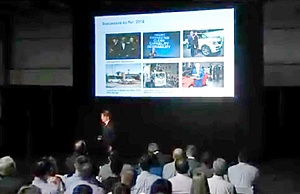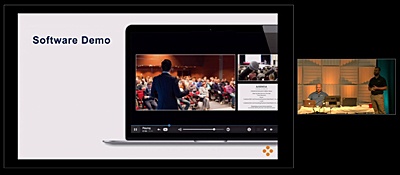As webcasting and the “Hybrid Meeting” become more prevalent in the event planning world, it’s increasingly vital for smart planners to know when the associated costs are justifiable, when they’re not, or even when to go with an alternative solution.
If you’re just starting out with the topic, we’d recommend going back to read our previous post about these Hybrid Meetings for some background info. But if you’re on the fence and looking for some guidance, we’ve broken down some common approaches to solving the main problem at hand: your program’s messaging needs to reach remote audiences.
First off, as is the case with most new technology, the appetite for webcasting often comes in the form of pressure from those who are not involved in planning it at all. It could be from young, tech savvy colleagues, or innovation-centric executives with only a surface-level understanding of how any of it works or the appropriate applications. But, before you jump head first into any one solution, consider all the options:
Travel
 This is self-explanatory, but if it makes the most sense to have your attendees in-house, then that may just be the best solution. Oftentimes in the case of conferences, networking is one of the main selling points. Connecting with like-minded individuals, potential business partners, or even just breaking down the “silos” of traditional corporations isn’t easily accomplished with webcasting. It may seem obvious, but if the in-person aspect of your event needs to be preserved, then you have your answer.
This is self-explanatory, but if it makes the most sense to have your attendees in-house, then that may just be the best solution. Oftentimes in the case of conferences, networking is one of the main selling points. Connecting with like-minded individuals, potential business partners, or even just breaking down the “silos” of traditional corporations isn’t easily accomplished with webcasting. It may seem obvious, but if the in-person aspect of your event needs to be preserved, then you have your answer.
Raw Footage
 Of course, many groups continue to use raw footage to bridge the gap between distant audiences, and for obvious reasons. It’s easily the least expensive way to share your event’s messaging with others at a later date; however, you are left with a completely unpolished product. For archival, or an event that doesn’t have any live visuals, this may be perfectly suitable. But if there is important visual content displayed at your live event, it will generally lose impact or even legibility with raw footage alone. A wide camera angle capturing both presenters and visual displays is one alternative, but it dilutes the presenter’s personal impact, the visuals look poor, and the overall product will come across as less professional. Of course, those visuals can be meticulously edited in later, but between that and distributing the product out to your remote audiences, you should plan for significant time expenditure.
Of course, many groups continue to use raw footage to bridge the gap between distant audiences, and for obvious reasons. It’s easily the least expensive way to share your event’s messaging with others at a later date; however, you are left with a completely unpolished product. For archival, or an event that doesn’t have any live visuals, this may be perfectly suitable. But if there is important visual content displayed at your live event, it will generally lose impact or even legibility with raw footage alone. A wide camera angle capturing both presenters and visual displays is one alternative, but it dilutes the presenter’s personal impact, the visuals look poor, and the overall product will come across as less professional. Of course, those visuals can be meticulously edited in later, but between that and distributing the product out to your remote audiences, you should plan for significant time expenditure.
Video On Demand
Especially in the case of organizations with an intercontinental reach, mitigating time zone differences can become a major obstacle for webcasting. Getting everyone tuned in at the same time has its merits, but in many cases the effort just may not be necessary. Even so, raw footage or an edited product are not your only options.
 Instead, consider that some platforms for webcasting can also be used in an ‘offline mode’ at a lower cost. Within 24 hours of the event, your remote audience can receive a web link to a branded webpage hosting the finished product, ready to display for 30 days or longer, and with minimal time spent by you. The visual content – slides, graphics, videos…etc. – and camera image are recorded and combined simultaneously right as they occur. It can even be played back in a picture-in-picture display. Missed a slide? Remote viewers can backtrack to visuals that may have been missed without bringing the show to a halt, and at their own time. All of this effectively eliminates any time otherwise spent in postproduction and data management, and ensures nothing gets lost in translation to a finished product. Beyond that, these solutions can even offer advanced viewer analytics, including metrics like: how many people viewed, when they tuned in, how long they watched, and so on. This could be highly useful for CME programs, or other certifications where quality of engagement is critical, or for general business updates that don’t necessarily require the immediacy that travel or webcasting can provide. The programming will dictate if that’s what’s needed, but you should weigh the cost of on demand video vs. how much time and resource you dedicate to handling raw footage – it may surprise you.
Instead, consider that some platforms for webcasting can also be used in an ‘offline mode’ at a lower cost. Within 24 hours of the event, your remote audience can receive a web link to a branded webpage hosting the finished product, ready to display for 30 days or longer, and with minimal time spent by you. The visual content – slides, graphics, videos…etc. – and camera image are recorded and combined simultaneously right as they occur. It can even be played back in a picture-in-picture display. Missed a slide? Remote viewers can backtrack to visuals that may have been missed without bringing the show to a halt, and at their own time. All of this effectively eliminates any time otherwise spent in postproduction and data management, and ensures nothing gets lost in translation to a finished product. Beyond that, these solutions can even offer advanced viewer analytics, including metrics like: how many people viewed, when they tuned in, how long they watched, and so on. This could be highly useful for CME programs, or other certifications where quality of engagement is critical, or for general business updates that don’t necessarily require the immediacy that travel or webcasting can provide. The programming will dictate if that’s what’s needed, but you should weigh the cost of on demand video vs. how much time and resource you dedicate to handling raw footage – it may surprise you.
Webcasting
Of course, webcasting can and will continue to be one of the most effective solutions for reaching remote audiences, and it offers all the advantages of video on demand with the added dimension of live engagement. Some programs simply require the live aspect, especially when the purpose is to control the delivery of new, sensitive information. In the case of general business updates – Q&A and audience engagement are key for empowering employees to have their voices heard. Most webcasting platforms include this feature, and you can also curate the questions that reach the stage.
For other types of events, it might just serve as a gateway to expanding the reach of your program. Facebook Live is now commonplace – but the production level is not limited to your smart phone’s camera; it can easily be a fully produced product. Webcasting might also be an opportunity to capitalize on new audiences with pay-to-play registration portals, or serve as digital real estate for sponsor signage. Since many webcasting platforms allow for branding and customization, you may find a sponsor that will cover the entire webcasting cost in itself.
If this post was helpful, and you’re ready to explore webcasting further, keep an eye out for our next posts, which will highlight some common issues to avoid, and then a deep-dive into some more advanced options and possibilities following that. If you would like to discuss options for your next event, please email us or contact us to learn more.


